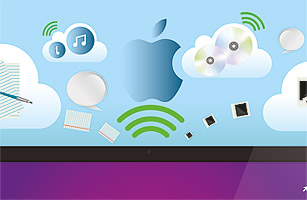
The best thing about cloud computing is that word: cloud. Telling consumers their data is in the cloud is like telling a kid his dog has gone to doggie heaven. There is no doggie heaven, and your data isn’t in a cloud. It’s in a windowless, fortress-like data center somewhere in the rural U.S. Cloud computing is just a buzzword companies use to describe what they’re doing when they move data and processing tasks you’re used to hosting on your personal computer — e-mail, word processing, media storage — onto their servers, which you can access via the Internet. It isn’t new; far from it. It’s at least as old as webmail services like Hotmail. It just didn’t have a cool name back then.
. Create a document, write an e-mail, buy a song — same deal: it gets backed up in doggie heaven and automatically redistributed across your personal hardware collection, no cumbersome USB synching required. Apple has struggled with cloud computing in the past — iCloud is the successor to MobileMe, which followed .Mac, which replaced iDisk — but this is the breakthrough, bolder and simpler than its forebears. It should launch this fall. As more and more of your data and software evaporate off your hard drive and ascend into the cloud, keep an eye on the larger trend that’s developing here and the trade-offs that come with it. You can see why Apple’s doing this. The more of your stuff that lives on its servers, the easier it is for Apple to manage its vast empire of users and devices and keep track of what they’re doing. Cloud computing gives Apple control, and if there’s one thing Jobs likes, it’s control.
Consumers get something out of it too: convenience. But in some ways, the cloud is a step backward. It harks back to computing’s primordial past, when everything was cloud computing — dumb terminals connected to central mainframes. When personal computers arrived, the power those mainframes once wielded migrated outward onto them, but now it appears to be reversing course. This is a big change, as Jobs pointed out. “We’re going to demote the PC and Mac to just be a device. We’re going to move the hub, the center of your digital life, to the cloud,” he said. The thing is, I’m not sure I want my computer to be just a device. Cloud computing goes hand in hand with another trend: the netbookization and iPadization of the PC, with its transformation into a beautifully designed but lobotomized device that relies on an Internet umbilical cord to do most of its actual computing. Personally, I prefer my computer to be a computer, not a pad or a pod. I like my data and my processing power and my digital life to be with me, where I have control. So far, it’s possible to have it both ways — feet on the ground, head in the cloud — but down the line, users may be forced to decide: Is keeping control of your data worth a little inconvenience? See photos of the history of the computer.
See TIME’s Steve Jobs covers.